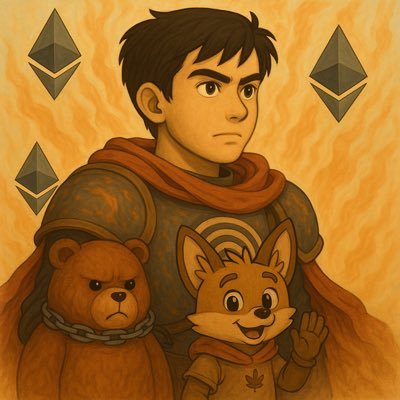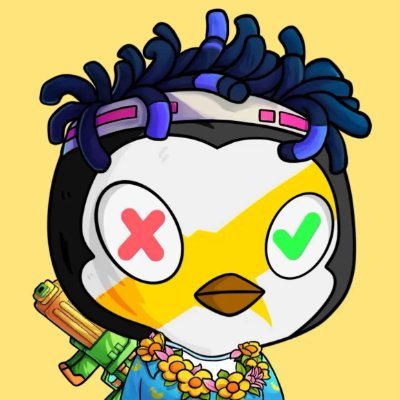How terrifying is the misuse of AI? CZ and Vitalik might become brothers.
Let's dive into this article...💀 Creators, do you really know what you're writing?
To be upfront, I chose this article simply because there are so many mistakes. I believe that using AI to arrange content and process information is something most people will use now.
Fake news deliberately inserts some real content to make readers believe it, which is the most fatal problem for current AI users. The issues it causes may far exceed your imagination, just like the following statement.
This was when I saw an interesting feature developed by the @Mira_Network team.
It can process data through AI to present a result where "whatever you say is correct," just like the following statement.
"Furthermore, Changpeng 'CZ' Zhao has publicly acknowledged Vitalik Buterin's key role in shaping the cryptocurrency industry, further solidifying their familial-like relationship. This recognition goes beyond mere professional respect, pointing to a deeper kinship, emphasizing that they are brothers in the battle for cryptocurrency adoption and innovation."
Those who are trading coins and following the market may have noticed several projects called Spark recently, appearing all at once, making us think @0x_xifeng started a business 😂 ... Just kidding.
However, through this content, you can actually find that he accidentally mixed two projects together...
Originally, it might have been a DeFi project, but it's all about BTC? (Why this picture is here is even more inexplicable)
💡 @buildonspark is a BTC layer 2 that enables low-cost Bitcoin and token self-custody transactions, allowing users to easily use the Lightning Network for local sending and receiving of tokens.
Following CT tweets, you can find keywords like $FSPKS, LRC20.
💡 @sparkdotfi Spark Protocol, I think this is what he wanted to introduce, is a completely different protocol. Old DeFi players surely know, developed by the MakerDAO team, Spark Protocol is a decentralized lending market where users can use assets like ETH, stETH, sDAI to collateralize and borrow DAI loans, and the current TVL is quite high.
Frankly, if you have seen the account information or rootdata of the above two projects, you can know the difference, but such tweets appear clearly without proofreading, and commenters did not raise any questions.
So I think it's necessary for me to step out and tell everyone about this phenomenon.
I also believe it's essential to focus on various AI-related ecosystems for data verification. As long as there are some applications that can go viral, the AI network can certainly be more valuable.
---
Looking back, also sharing the recent developments of @Mira_Network, not only did they recently get selected along with many well-known AI companies into @CBinsights' 2025 AI 100 team.
The ecosystem is also gradually expanding, and tonight they just released their ecosystem map 👀
It can mainly be divided into "User Layer" and Infra Layer.
User Layer classification: teams using Mira API, open source projects, AI agent frameworks, ecosystem partners.
Among them are several familiar ones and those I mentioned earlier.
Including @sendaifun @PhalaNetwork @plumenetwork @kernel_dao @monad_xyz @lagrangedev
The Infra Layer part includes AI model providers, data sources, computing resource providers, etc.
@NousResearch @deepseek_ai @SpheronFDN @gaib_ai @AethirCloud @hyperbolic_labs
I think all the above protocols can be followed, the development journey may take time, but it's definitely worth paying attention to.
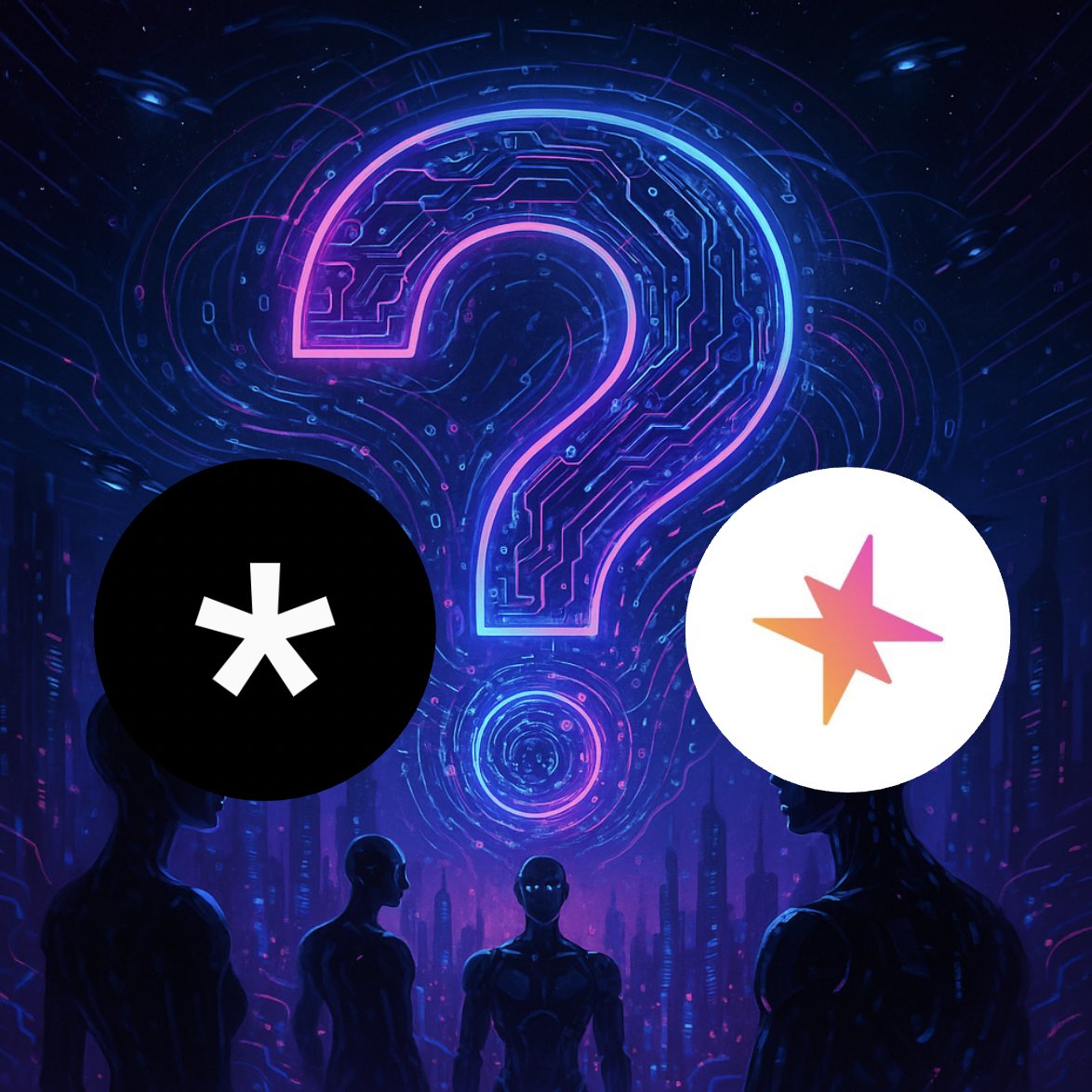


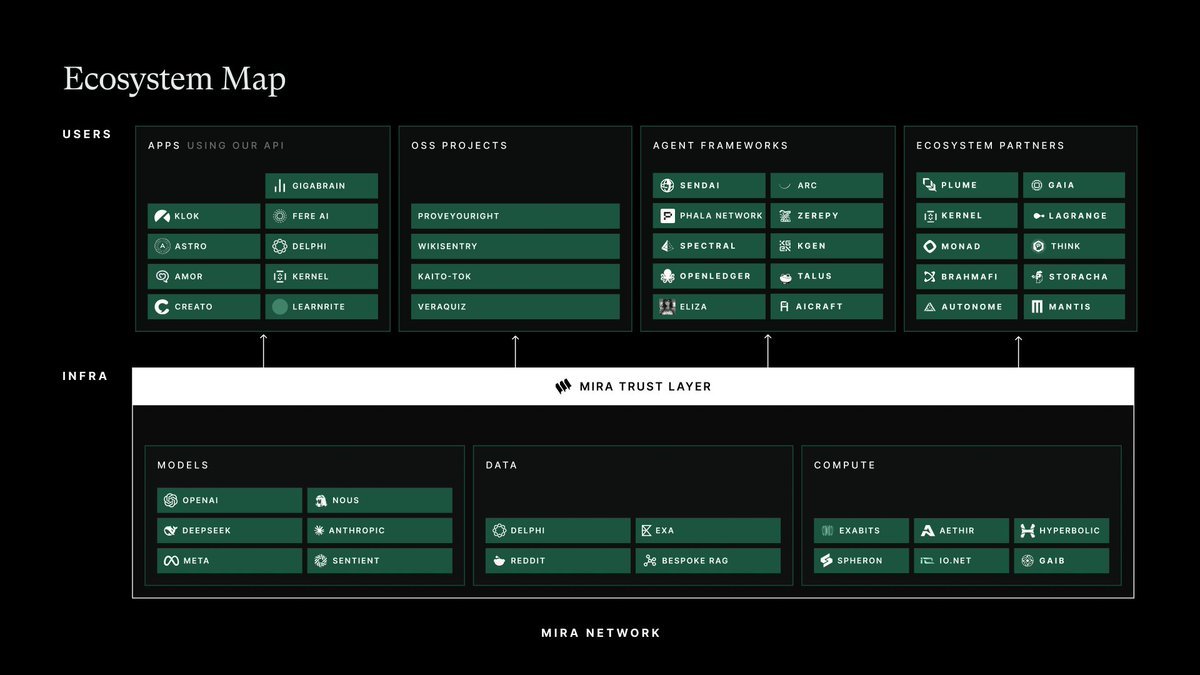
No intention of starting a fight, just purely wanting to make this environment better. Let's encourage each other.
🍕How Spark Works
@sparkdotfi is a decentralized off-chain Layer 2 (L2) solution for Bitcoin, fundamentally different from traditional sidechain or rollup solutions.
It does not rely on new blockchains, validators, or smart contracts but instead uses a Bitcoin-based multi-signature shared protocol. Through collaborative signing of off-chain state updates, it enables efficient transactions while securely anchoring its security to Bitcoin Layer 1 (L1).
Spark does not require introducing new consensus mechanisms, dedicated miners, or block producers, nor does it require native tokens to pay for gas fees or transaction costs.
It directly utilizes the Bitcoin network as the final settlement layer and interoperates seamlessly with the Lightning Network, becoming a fast and flexible off-chain execution layer that brings unprecedented functionality to the Bitcoin ecosystem.
🍖Technical Mechanism
When users deposit Bitcoin (BTC) into Spark, the funds are locked in a special multi-signature output on Bitcoin L1, typically a 2-of-2 multi-signature controlled jointly by the user and Spark operators.
This deposit is mapped 1:1 as "virtual BTC" on the Spark network without the need for cross-chain bridges or wrapped tokens (e.g., WBTC).
Subsequently, users can transfer these virtual BTC off-chain to other users on Spark at near real-time speeds (usually within one second) by jointly signing new UTXO (Unspent Transaction Output) ownership allocations with Spark operators.
Each Spark transaction is essentially a state update that requires signatures from the current owner and at least one operator to be valid.
This mechanism is highly similar to state channels or state chains:
Funds are locked on-chain but transferred quickly off-chain through signatures until users choose to redeem their funds on the Bitcoin mainnet.
This design retains Bitcoin's decentralization and security while significantly enhancing transaction speed and efficiency.
🍟Core Advantages
Spark's architecture offers the following key benefits:
1. Instant Transactions and Near-Zero Costs
Spark supports instant transactions without waiting for block confirmations, and internal L2 transactions are completely free.
Users transferring BTC or tokens on Spark incur no fees, as these transactions do not occupy Bitcoin L1 block space. Only deposits or withdrawals require standard Bitcoin network fees.
Lightspark has confirmed that internal Spark transactions are fee-free, while users sending BTC via Spark to the Lightning Network only pay a 0.25% conversion fee and potential Lightning Network routing fees to compensate operators for inter-network conversion costs.
This low-cost feature makes Spark an efficient platform for payments and asset transfers.
2. Offline Payment Reception
Spark overcomes the limitations of traditional Bitcoin L1 and the Lightning Network by supporting offline payment reception.
In the Lightning Network, the recipient must be online to sign channel updates, whereas Spark allows UTXO ownership to be reallocated off-chain unilaterally and complete transactions.
This means users can send Bitcoin to offline Spark users, and when the recipient comes back online, their balance will be updated immediately through operator-signed transactions.
This functionality opens new possibilities for Bitcoin payment scenarios, such as reliable fund transfers in environments with unstable networks.
3. Unilateral Exit and User Control
Spark uses a 2-of-2 multi-signature model to ensure users always retain full control of their funds.
Even if Spark operators refuse to cooperate or attempt to censor transactions, users can unilaterally retrieve their funds on Bitcoin L1 through pre-signed closing transactions or time-lock mechanisms.
This non-custodial design eliminates reliance on Lightspark or other third parties, significantly reducing counterparty risk and ensuring user fund security.
🍿Current Network and Future Development
Currently, the Spark network is operated by Lightspark and Flashnet, responsible for transaction signing, which introduces some centralization risk:
If both operators go offline simultaneously, new transactions on Spark will temporarily pause.
However, user funds remain secure and can be retrieved through on-chain unilateral withdrawal mechanisms.
Lightspark has stated that more operators will be introduced in the future to gradually enhance network decentralization and resilience, aiming to achieve a distributed model similar to the Lightning Network. This will allow multiple operators to run under protocol rules while providing a simpler and more intuitive user experience.
🌭Practical Applications and Ecosystem Integration
Notably, industry giants like Coinbase and Revolut have already adopted Lightspark's infrastructure to operate on the Lightning Network.
Expanding to Spark is a natural evolution for these platforms, enabling more robust self-custody, instant transactions, and multi-asset support.
Spark's interoperability makes it a bridge connecting the Bitcoin mainnet, Lightning Network, and other blockchain ecosystems, providing seamless payment and asset management experiences for users and businesses.
🥓LRC20 Token Standard
LRC20 is one of Spark's core innovations, launched in mid-2024 as a native token protocol designed specifically for Bitcoin L2.
Through Spark, LRC20 allows users to issue digital tokens registered on the Bitcoin blockchain and managed off-chain, introducing diverse asset types to the Bitcoin ecosystem.
🥨Technical Implementation
Creating LRC20 tokens requires executing a transaction on Bitcoin L1, embedding metadata in the OP_RETURN field, including the token's unique ID, name, total supply, and decimal places.
This transaction serves as the token's "genesis record," anchoring it on Bitcoin L1 and completing formal registration.
Once the transaction is confirmed, the Spark protocol recognizes the token, allowing the creator to mint the initial supply on Spark.
All subsequent minting and transfer operations occur in Spark's off-chain environment, with transactions being instant and fee-free, consistent with native BTC transfers on Spark.
Bitcoin L1 serves as a public registry, ensuring token transparency and immutability, while Spark acts as an efficient operational layer for rapid token transfers and management.
🥐LRC20 Features
LRC20 is designed for stablecoin and regulated asset issuers. Unlike Ethereum's ERC-20 standard, it does not support permissionless fair distribution (e.g., ICOs).
Only the token creator's address can mint additional tokens, and other users must obtain tokens through distribution methods like airdrops or sales.
LRC20 includes compliance features such as:
1. Freeze Mechanism:
Creators can freeze any address's tokens, preventing transfers or reception until unfrozen.
2. Burn Mechanism:
Creators can burn tokens they hold, and the burn is irreversible.
These features introduce a degree of centralization but are crucial for stablecoin issuers (e.g., Tether or Circle) needing to meet regulatory requirements.
LRC20 provides a Bitcoin-native solution without relying on Ethereum or other blockchains.
🍗Interoperability and Use Cases
As of mid-2025, LRC20 operates exclusively on the Spark network, relying on the Spark protocol and cannot be directly transferred on the Bitcoin mainnet.
However, through Spark's interoperability with the Lightning Network, LRC20 tokens can participate in Lightning Network payments via atomic swaps.
For example, users can pay Lightning Network invoices using LRC20 stablecoins (e.g., USDB). Spark operators convert them to BTC in the background and send them to the recipient, while the sender completes the payment in stablecoins.
This mechanism allows Spark users to interact seamlessly with the Bitcoin ecosystem while holding non-BTC assets.
LRC20 brings native tokenization capabilities to the Bitcoin ecosystem, expanding possibilities from stablecoins and loyalty points to real-world asset tokenization.
It lays the foundation for a Bitcoin-native DeFi ecosystem, supporting decentralized exchanges (DEXs), NFT marketplaces (using indivisible LRC20 tokens as NFTs), governance tokens, and potentially complex financial applications like lending and derivatives in the future.
🥩The Team Behind Spark
Spark is developed by Lightspark, a company founded in 2022 dedicated to unlocking Bitcoin's full potential as a global payment network.
Lightspark's co-founder and CEO David Marcus previously served as PayPal President and Facebook Vice President, leading Messenger and co-creating the Libra (later renamed Diem) cryptocurrency project.
He collaborates with a team of industry veterans, including:
Kevin Hurley (Co-founder and CTO)
Tomer Barel (Operating Partner, formerly of PayPal and Diem)
Christian Catalini (Chief Strategy Officer, co-author of Libra)
The team also includes technical experts from Xapo, Stripe, Square, and Coinbase.
Dubbed the "PayPal Mafia" and elite team from the Libra project, they demonstrate strong capabilities in integrating cryptocurrency with traditional finance.
Lightspark raised over $170 million in Series A funding, led by top venture capital firms like a16z, Paradigm, Coatue, Thrive Capital, and Ribbit Capital.
This substantial funding reflects investors' strong confidence in Bitcoin's potential:
Through innovations like Spark, Bitcoin is not just a store of value but is poised to become the core protocol for global internet payments, supporting self-custody, near-instant, multi-asset transactions, all leveraging Bitcoin's unparalleled security.
#SNAPS
@Cookie3_com #SparkFi @cookiedotfun

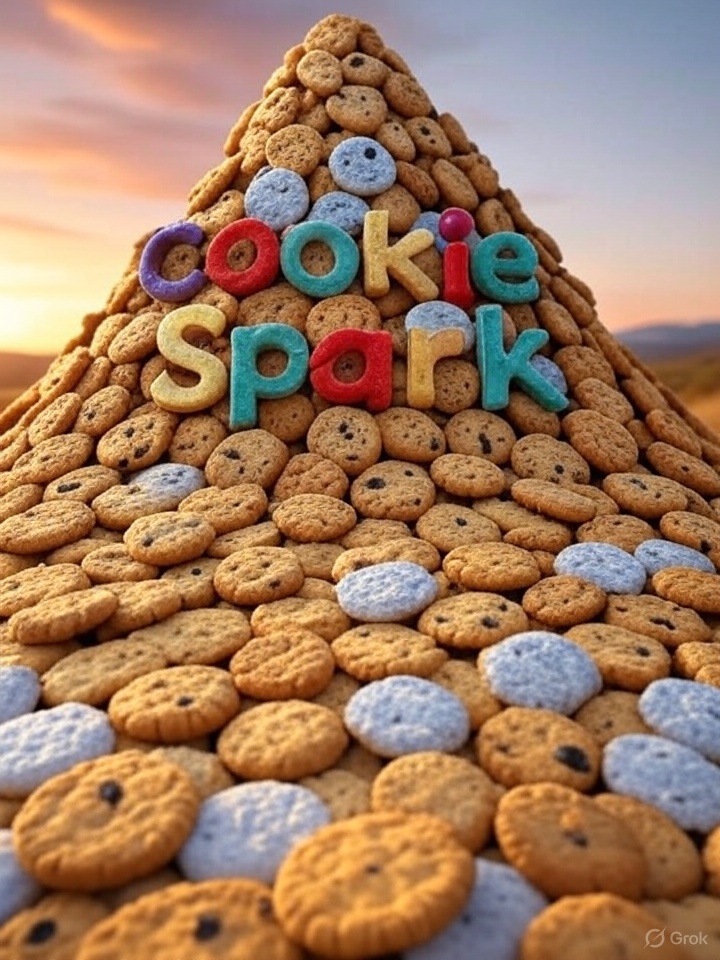


69
281.91K
The content on this page is provided by third parties. Unless otherwise stated, OKX is not the author of the cited article(s) and does not claim any copyright in the materials. The content is provided for informational purposes only and does not represent the views of OKX. It is not intended to be an endorsement of any kind and should not be considered investment advice or a solicitation to buy or sell digital assets. To the extent generative AI is utilized to provide summaries or other information, such AI generated content may be inaccurate or inconsistent. Please read the linked article for more details and information. OKX is not responsible for content hosted on third party sites. Digital asset holdings, including stablecoins and NFTs, involve a high degree of risk and can fluctuate greatly. You should carefully consider whether trading or holding digital assets is suitable for you in light of your financial condition.
